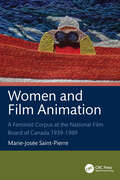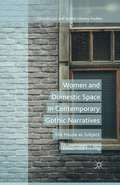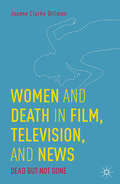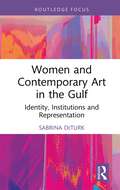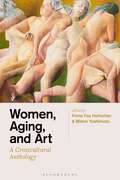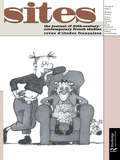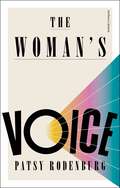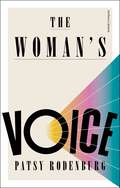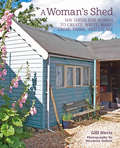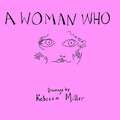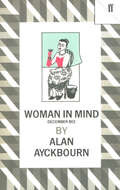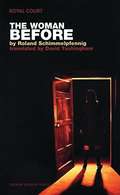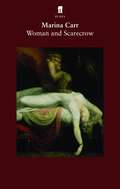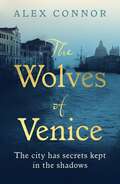- Table View
- List View
Women and Film Animation: A Feminist Corpus at the National Film Board of Canada 1939-1989
by Marie-Josée Saint-PierreThe creations of female animation filmmakers are recognized all over the world while being, paradoxically, unknown to the general public. Women and Film Animation: A Feminist Corpus at the National Film Board of Canada 1939-1989 brings out of the shadows the work of true pioneers by presenting and analyzing, from a resolutely feminist perspective, the works they have conceived within the National Film Board of Canada (NFB).This institution has played an essential role in the emergence of animated cinema in Canada, but it is forgotten or ignored that a good part of this vast corpus is the work of women who have worked there not only as assistants but also as directors. These artists have contributed to changing the traditional representations of women in a unique way in both commercial and avant-garde animated cinema. The author accounts for their concerns, their creativity, and their many bright achievements. To do this, she relies on a wide range of critical works in social and cultural history of Canada, in feminist art history, and on multiple studies on animated cinema.Key Features: Provides an interdisciplinary approach that combines concepts from feminist studies, film theory and visual arts for a nuanced analysis of the role of women in animated cinema Discusses historical and sociological background that sheds light on the condition of women Includes a profound analysis of the changes and continuities in the role of women in this industry over time, focusing on the National Film Board of Canada Features previously unreleased archival material and selected excerpts from reviews by the NFB’s programming committee, highlighting the impact of production circumstances of the works of specific women animators
Women and Film Animation: A Feminist Corpus at the National Film Board of Canada 1939-1989
by Marie-Josée Saint-PierreThe creations of female animation filmmakers are recognized all over the world while being, paradoxically, unknown to the general public. Women and Film Animation: A Feminist Corpus at the National Film Board of Canada 1939-1989 brings out of the shadows the work of true pioneers by presenting and analyzing, from a resolutely feminist perspective, the works they have conceived within the National Film Board of Canada (NFB).This institution has played an essential role in the emergence of animated cinema in Canada, but it is forgotten or ignored that a good part of this vast corpus is the work of women who have worked there not only as assistants but also as directors. These artists have contributed to changing the traditional representations of women in a unique way in both commercial and avant-garde animated cinema. The author accounts for their concerns, their creativity, and their many bright achievements. To do this, she relies on a wide range of critical works in social and cultural history of Canada, in feminist art history, and on multiple studies on animated cinema.Key Features: Provides an interdisciplinary approach that combines concepts from feminist studies, film theory and visual arts for a nuanced analysis of the role of women in animated cinema Discusses historical and sociological background that sheds light on the condition of women Includes a profound analysis of the changes and continuities in the role of women in this industry over time, focusing on the National Film Board of Canada Features previously unreleased archival material and selected excerpts from reviews by the NFB’s programming committee, highlighting the impact of production circumstances of the works of specific women animators
Women and Domestic Space in Contemporary Gothic Narratives: The House as Subject (Geocriticism and Spatial Literary Studies)
by A. Soon Andrew Hock Soon NgMoving away from traditional studies of Gothic domesticity based on symbolism, Soon instead focuses on domestic space's material presence and the traces it leaves on the human subjects inhabiting it. Approaching novels and films such as Beloved and The Exorcist , this study intersects psychoanalysis, phenomenology, and various spatial theories.
Women and Death in Film, Television, and News: Dead but Not Gone
by Joanne Clarke DillmanDead women litter the visual landscape of the 2000s. In this book, Clarke Dillman explains the contextual environment from which these images have arisen, how the images relate to (and sometimes contradict) the narratives they help to constitute, and the cultural work that dead women perform in visual texts.
Women and Contemporary Art in the Gulf: Identity, Institutions and Representation (Cultural Heritage, Art and Museums in the Middle East)
by Sabrina DeTurkWomen and Contemporary Art in the Gulf offers a unique focus on the roles of women in contemporary art, cultural production and arts institutions in the Gulf. Drawing on in-person experiences of the art and sites discussed, as well as research on regional artists and arts institutions, DeTurk argues that the Gulf Cooperation Council (GCC) countries of Bahrain, Kuwait, Oman, Qatar, Saudi Arabia and the United Arab Emirates have been largely excluded from the critical discourse about, and display of, contemporary Middle Eastern art. The book addresses this oversight by providing an examination of the work of several contemporary women artists from the Gulf region. DeTurk also discusses the role of women in museums and cultural institutions in the region, as well as the education systems available to emerging women artists. The discussion and analysis at the heart of the book connect to a range of larger themes, including the visual culture of patriarchy, connection to material culture and heritage, religious beliefs, trade and migration, rapid development, and the need to envision and create a post-oil economy. Women and Contemporary Art in the Gulf, with its examination of the critical role women play in the formation of the cultural landscape of the Gulf, is an important contribution to discourse around the changing role of the GCC. It will be essential reading for scholars and students engaged in the study of art history, visual culture, museums and heritage, and women and gender studies.
Women and Contemporary Art in the Gulf: Identity, Institutions and Representation (Cultural Heritage, Art and Museums in the Middle East)
by Sabrina DeTurkWomen and Contemporary Art in the Gulf offers a unique focus on the roles of women in contemporary art, cultural production and arts institutions in the Gulf. Drawing on in-person experiences of the art and sites discussed, as well as research on regional artists and arts institutions, DeTurk argues that the Gulf Cooperation Council (GCC) countries of Bahrain, Kuwait, Oman, Qatar, Saudi Arabia and the United Arab Emirates have been largely excluded from the critical discourse about, and display of, contemporary Middle Eastern art. The book addresses this oversight by providing an examination of the work of several contemporary women artists from the Gulf region. DeTurk also discusses the role of women in museums and cultural institutions in the region, as well as the education systems available to emerging women artists. The discussion and analysis at the heart of the book connect to a range of larger themes, including the visual culture of patriarchy, connection to material culture and heritage, religious beliefs, trade and migration, rapid development, and the need to envision and create a post-oil economy. Women and Contemporary Art in the Gulf, with its examination of the critical role women play in the formation of the cultural landscape of the Gulf, is an important contribution to discourse around the changing role of the GCC. It will be essential reading for scholars and students engaged in the study of art history, visual culture, museums and heritage, and women and gender studies.
Women, Aging, and Art: A Crosscultural Anthology
by Frima Fox Hofrichter and Midori YoshimotoWhat images come to mind with the words “women”, “aging”, “old”, even “elderly”? Are they stereotypes? Are there anypositive associations? The thirteen contributions to this edited volume explore a broad range of images of old women, ranging from medieval “old wives” to contemporary re-imaginations of shamans and witches and empowering self-portraits. Works from medieval Europe to colonialtime Polynesia, present West Africa, Japan, and the Americas, in a multiplicity of media are explored in detail. These studies of varied representations of “old women” offer fresh perspectives and an engaging dialogue about society's values and preconceptions regarding the wisdom of our elders and the “golden years” in different times and cultures.
Women, Aging, and Art: A Crosscultural Anthology
What images come to mind with the words “women”, “aging”, “old”, even “elderly”? Are they stereotypes? Are there anypositive associations? The thirteen contributions to this edited volume explore a broad range of images of old women, ranging from medieval “old wives” to contemporary re-imaginations of shamans and witches and empowering self-portraits. Works from medieval Europe to colonialtime Polynesia, present West Africa, Japan, and the Americas, in a multiplicity of media are explored in detail. These studies of varied representations of “old women” offer fresh perspectives and an engaging dialogue about society's values and preconceptions regarding the wisdom of our elders and the “golden years” in different times and cultures.
Women
by Roger CélestinPublished in 2001, Women is a valuable contribution to the field of Performance.
Women
by Revue D’études FrançaisesPublished in 2001, Women is a valuable contribution to the field of Performance.
A Woman's World, 1850–1960: Scientists, Soldiers, Artists, Explorers, Queens And Rebels
by Dan Jones Marina AmaralThe third volume in the much-admired The Colour of Time series.A Woman's World, 1850–1960 explores the many roles – domestic, social, cultural and professional – played by women across the world before second-wave feminism took hold. Using Marina Amaral's colourized images and Dan Jones's words, this survey features women both celebrated and ordinary, whether in the science lab or protesting on the streets, performing on stage or fighting in the trenches, running for election or exploring the wild. This vivid and unique history brings to life and full colour the female experience in a century of extraordinary change.Photographs include: Queen Victoria, Edith Cavell, Josephine Baker, Eva Peron, Virginia Woolf, Clara Schumann, Martha Gellhorn, Rosa Parks, Agatha Christie, Frida Kahlo, Harriet Tubman, Florence Nightingale, Hattie McDaniel and Gertrude Bell; as well as revolutionaries from China to Cuba, Geishas in Japan, protestors on the Salt March, teachers and pilots, nurses and soldiers.
The Woman’s Voice
by Patsy RodenburgWhy are women still often not properly listened to? Why are they sometimes perceived to be less interesting than they are? Why do women tend to rush when they speak? Why do many women feel the pressure to sound like girls when they speak? From one of the world's leading experts on voice work comes this book, which is a call to arms for women to reclaim their voices. Arguing that power and voices are directly linked to breath, Rodenburg makes the case that Western society's oppression of women has diminished their natural ability to breathe. She examines all of these questions, and many more, to decipher what lies at the heart of female empowerment when it comes to the voice. Combining elements of experience and practice from her prolific career, Rodenburg interrogates Shakespeare's texts and presentation of female characters; develops the notion of rhetoric in relation to the female voice; and applies concepts explored in her previous books, such as the three circles of presence. Exploring the female voice through practical exercises and stories from the front line, as well as profoundly personal and formative experiences from her own life, Rodenburg defines the art of accessing the voice within and reclaiming the woman's right to speak.
The Woman’s Voice
by Patsy RodenburgWhy are women still often not properly listened to? Why are they sometimes perceived to be less interesting than they are? Why do women tend to rush when they speak? Why do many women feel the pressure to sound like girls when they speak? From one of the world's leading experts on voice work comes this book, which is a call to arms for women to reclaim their voices. Arguing that power and voices are directly linked to breath, Rodenburg makes the case that Western society's oppression of women has diminished their natural ability to breathe. She examines all of these questions, and many more, to decipher what lies at the heart of female empowerment when it comes to the voice. Combining elements of experience and practice from her prolific career, Rodenburg interrogates Shakespeare's texts and presentation of female characters; develops the notion of rhetoric in relation to the female voice; and applies concepts explored in her previous books, such as the three circles of presence. Exploring the female voice through practical exercises and stories from the front line, as well as profoundly personal and formative experiences from her own life, Rodenburg defines the art of accessing the voice within and reclaiming the woman's right to speak.
A Woman’s Shed
by Gill HerizBecause sheds aren't just for men – this selection of sheds from the UK, North America and Europe shows how women everywhere can claim and use their own personal space.
Woman's Hour: Words From Wise, Witty And Wonderful Women
by Alison Maloney Jenni MurrayFor the last 70 years, the guests of Woman’s Hour have been entertaining listeners with their compelling combination of wit, warmth, insight and humour. Woman’s Hour has interviewed many of the biggest female names from entertainment, politics, the arts and beyond.Words from Wise, Witty and Wonderful Women is a collection of quotes and extracts from 70 years of the Woman’s Hour archive, featuring some of the most memorable guests to appear on the programme, from Doris Lessing to Nora Ephron, Hilary Clinton to J.K. Rowling, and Bette Davis to Meryl Streep. Charting the social and political revolution that has taken place in women’s lives over the past 70 years, as well as the perennial aspects of female life, such as love, family, relationships, the workplace, sex, ageing, and food, this delightful book shares fascinating insights and sage advice from the wise and wonderful women that have graced the Woman’s Hour airwaves over the decades.
The Woman's Film of the 1940s: Gender, Narrative, and History (Routledge Advances in Film Studies)
by Alison L. McKeeThis book explores the relationship among gender, desire, and narrative in 1940s woman’s films which negotiate the terrain between public history and private experience. The woman’s film and other form of cinematic melodrama have often been understood as positioning themselves outside history, and this book challenges and modifies that understanding, contextualizing the films it considers against the backdrop of World War II. In addition, in paying tribute to and departing from earlier feminist formulations about gendered spectatorship in cinema, McKee argues that such models emphasized a masculine-centered gaze at the inadvertent expense of understanding other possible modes of identification and gender expression in classical narrative cinema. She proposes ways of understanding gender and narrative based in part on literary narrative theory and ultimately works toward a notion of an androgynous spectatorship and mode of interpretation in the 1940s woman’s film.
The Woman's Film of the 1940s: Gender, Narrative, and History (Routledge Advances in Film Studies)
by Alison L. McKeeThis book explores the relationship among gender, desire, and narrative in 1940s woman’s films which negotiate the terrain between public history and private experience. The woman’s film and other form of cinematic melodrama have often been understood as positioning themselves outside history, and this book challenges and modifies that understanding, contextualizing the films it considers against the backdrop of World War II. In addition, in paying tribute to and departing from earlier feminist formulations about gendered spectatorship in cinema, McKee argues that such models emphasized a masculine-centered gaze at the inadvertent expense of understanding other possible modes of identification and gender expression in classical narrative cinema. She proposes ways of understanding gender and narrative based in part on literary narrative theory and ultimately works toward a notion of an androgynous spectatorship and mode of interpretation in the 1940s woman’s film.
A Woman Who
by Rebecca MillerA Woman Who is a delightful collection of clever, almost surreal drawings revealing women feeling all the strange and specific things they feel - as conjured up by artist/writer/filmmaker Rebecca Miller, who draws each image with her eyes closed. Bored, sexy, angry, amused, ambivalent, overwhelmed, curious, so serene they can barely speak - these women come straight from the unconscious, and you'll recognize them at once. A woman who has so many things to do that she can't bring herself to do any of them. A woman who is flying for the first time. A woman who was okay a second ago. A woman who would like some attention but isn't sure how to get it in a subtle way. A woman who is worried she's so happy she'll never have another idea. They're all here- in the perfect gift book for all the women in your life.
A Woman Looking at Men Looking at Women: Essays on Art, Sex, and the Mind
by Siri HustvedtA trail-blazing and inspiring collection of essays on art, feminism, neuroscience and psychology featuring The Delusions of Certainty, winner of the European Essay Prize 2019.As well as being a prize-winning, bestselling novelist, Siri Hustvedt is widely regarded as a leading thinker in the fields of neurology, feminism, art criticism and philosophy. She believes passionately that art and science are too often kept separate and that conversations across disciplines are vital to increasing our knowledge of the human mind and body, how they connect and how we think, feel and see. The essays in this volume - all written between 2011 and 2015 - are in three parts. A Woman Looking at Men Looking at Women brings together penetrating pieces on particular artists and writers such as Picasso, Kiefer and Susan Sontag as well as essays investigating the biases that affect how we judge art, literature, and the world in general. The Delusions of Certainty is an essay about the mind/body problem, showing how this age-old philosophical puzzle has shaped contemporary debates on many subjects and how every discipline is coloured by what lies beyond argument-desire, belief, and the imagination. The essays in the final section, What Are We? Lectures on the Human Condition, tackle such elusive neurological disorders as synesthesia and hysteria. Drawing on research in sociology, neurobiology, history, genetics, statistics, psychology and psychiatry, this section also contains a profound consideration of suicide and a towering reconsideration of Kierkegaard. Together they form an extremely stimulating, thoughtful, wide-ranging exploration of some of the fundamental questions about human beings and the human condition, delivered with Siri Hustvedt's customary lucidity, vivacity and infectiously questioning intelligence.
Woman in Mind
by Alan AyckbournThe central character of Alan Ayckbourn's new play is Susan, a parson's wife, 'one of the most moving and devastating that he has created...'Robin Thornber reviewing the first production in Scarborough in the Guardian.
Woman in Lars von Trier’s Cinema, 1996–2014
by Ahmed ElbeshlawyThis book discusses the figure of Woman in Lars von Trier’s distinctive cinematic productions from 1996 to 2014. It takes the notorious legacy of violence against women in von Trier’s cinema beyond the perceived gender division, elevating the director’s image above being a mere provocateur. By raising fundamental questions about woman, sexuality, and desire, Elbeshlawy shows that Trier’s cinematic Woman is an attempt at creating an image of a genderless subject that is not inhibited by the confines of ideology and culture. But this attempt is perennially ill-fated. And it is this failure that not only fosters viewing enjoyment but also gives the films their political importance, elevating them above both commendations and condemnations of feminist discourse.
The Woman Before (Oberon Modern Plays)
by David Tushingham Roland Schimmelpfennig‘You swore that you’d love me for ever’Frank doesn’t recognise the woman at the door. She’s come to remind him of a promise he made twenty years before. A darkly humorous study of modern relationships and the things we say that may come back to haunt us. The Woman Before opened at the Royal Court Theatre in May 2005.
Woman and Scarecrow: On Raftery's Hill; Ariel; Woman And Scarecrow; The Cordelia Dream; Marble
by Marina CarrA woman - gaunt and ill, haggard after giving birth eight times - faces death. What was life? What was love? What else could have been? Full of mordant, bitter humour, this is a passionate threnody from one of Ireland's leading playwrights.Woman and Scarecrow premieres at the Royal Court Theatre, London, in June 2006.
The Wolves of Venice: A gripping historical thriller from the bestselling author of The Caravaggio Conspiracy
by Alex ConnorThe city has secrets kept in the shadows. Venice, 16th century. The staggering wealth of Venice contrasts the brutal lives of those in the ghetto. Opportunistic merchants arrive to make their fortune. Deception, malice and perversion thrive, leading to the emergence of a dark society: The Wolves of Venice. Drawn into the Wolves' plots are the innocents – including Marco Gianetti, assistant to Tintoretto; Ira Tabat, a Jewish merchant; Giorgio Gabal, an artist's apprentice; and Giovanni Spoletto, the doomed castrato – all manipulated by the likes of Pietro Aretino, the courtesan Tita Boldini and the spy Adamo Baptista. The lives of these characters criss-cross one another. Their destinies intermingle in a Venice corrupted by spies lingering in the shadows, working for paymasters that change allegiance with the wind. As the betrayals, murders and tragedies continue, will anyone be able to bring the Wolves of Venice to justice? Praise for Alex Connor: 'Alex Connor is a master at keeping the pace moving [and] keeps you turning the pages even though you promised yourself to put the light out fifteen minutes ago!' HISTORICAL NOVEL REVIEW. 'A deep knowledge of the art world is displayed by Connor... The pace is steady with spikes of frantic action... A marvellous twist at the end' CRIMESQUAD. 'A truly superb book... The end is totally unexpected. Highly recommended' EURO CRIME. 'The book sped by and entertained me immensely. I will be without doubt picking up the other books by this author, finding a good thriller writer is hard, finding a great one is nigh on impossible' PARMENION BOOKS. 'Convincing characters and a fast-moving plot lift this above the pack of mystery thrillers centered on an old work of art' PUBLISHERS WEEKLY.
